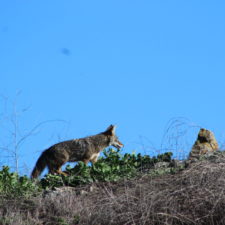Laguna Canyon Foundation’s Restoration Team does a variety of fieldwork in the wilderness parks and around our local cities to preserve native habitat: big-leaved crownbeard conservation along Nyes Place in Laguna Beach, invasive plant removal at Laguna Creek off the 133, habitat surveying at Aliso Creek, CRAMs, WRAMPs*, and irrigation are all in a day’s work for the restoration crew.
However, if you asked any one of the six-member team what this week’s task is, it would be one word: planting.
Last week: “Planting at Pecten Reef.”
Next week: “Planting at Pecten Reef.”

Thanks to a five-year grant from California State Coastal Conservancy that builds upon a successful history of preservation, coalitions and volunteer support, Laguna Canyon Foundation, along with several partners, including OC Parks and California Conservation Corps (CCCs), is in the third year of a five-year project to restore Pecten Reef. This is just one of seventeen conservation projects Laguna Canyon Foundation is managing.
What seems a bit of a non sequitur – land conservation at a reef – it is exactly as it reads. Pecten Reef is an 18 million-year-old marine fossil formation landlocked near the southern portion of Aliso Creek.
Running nearly 20 miles from the Santa Ana Mountains to the Pacific Ocean, Aliso Creek was historically used for cattle and sheep ranching. Over the past 40 years, this watershed has been almost completely developed into an urban area comprising seven cities. As a result of the rapid urbanization, Aliso Creek is federally listed as impaired waters due to high levels of urban runoff and invasive species.
The Pecten Reef Habitat Restoration and Enhancement Project consists of 26 acres of wetland, riparian, riparian-transitional, and upland habitats that will be ultimately restored through native plant installation.
Prior to planting, though, much clean-up and preparation work had to be done. The first and second year of work at Pecten Reef included:
- Site preparation: creation of a project yard, project container, fencing, and general staging.
- First round invasive plant removal: black mustard, Sahara mustard, tocolote, pampas grass, artichoke thistle, fennel, arundo and tree tobacco.
- Debris Removal and Recycling: more than 390 tons of material that included old asphalt and guard rails, invasive vegetation, and garbage – anything from discarded blenders and furniture to abandoned human encampments.
- Swale Installation: to improve water retention, infiltration and biofiltration of polluted runoff from the adjacent road and housing development. In addition, three distinct pool areas were created to collect overflow water during rain events.
- Irrigation: The dry and hot year of 2018 required supplemental irrigation and hand-watering of newly installed plants.
- Plant acquisition and first round of planting: 14,000 native plants and over 1,000 pounds of native seed were including but not limited to: sagebrush, wild rye, California melic, California blackberry, sage, lupine, and Parry’s phacelia
- Regular Monitoring*: Creating and conducting WRAMPs (Wetland Riparian Area Monitoring Plan) and CRAMs (California Rapid Assessment Method) to both assess baseline status and continued overall health of the project site.
This past year’s timing couldn’t be better. With the 2019 rain and the resulting super bloom, the success rate of native planting was remarkable. What was once bare soil, if not broken asphalt, is now full of native vegetation. With debris and choking invasives now removed and native plants thriving, the hydrology of Aliso Creek flows freely, creating and sustaining a critical natural wildlife corridor and migration area in the midst of an otherwise urban environment.

As with any ecosystem, it starts small. Native plants attract native insects, which attract native wildlife, which attract megafauna, bringing balance back to this delicate riparian area, rich in biodiversity.
While all native wildlife is important, because of their endangered and at-risk status, three species are a focus in this project: Least Bell’s Vireo, southwestern pond turtle, and California Gnatcatcher. The first year, there were a few isolated observations of Least’s Bell’s Vireo in the project area. In the second year, Least Bell’s Vireo were seen regularly in two separate territories. Expert Barry Nerhus surveyed the site in 2019 for southwestern pond turtles and found older turtles and very young turtles, hypothesizing that after the dense patches of arundo were removed from the riparian channel, there was likely an increase in breeding.
As we continue our conservation work, we eagerly await the sound or sight of a California Gnatcatcher coming from one of our newly established sagebrush bushes.
Want to join us and learn more? Visit https://lagunacanyon.org/events/#volunteer. For group volunteering or a group tour, contact cameron@lagunacanyon.org
Photos by: Josie Bennett, Alyssa Moreno and Paula Olson








